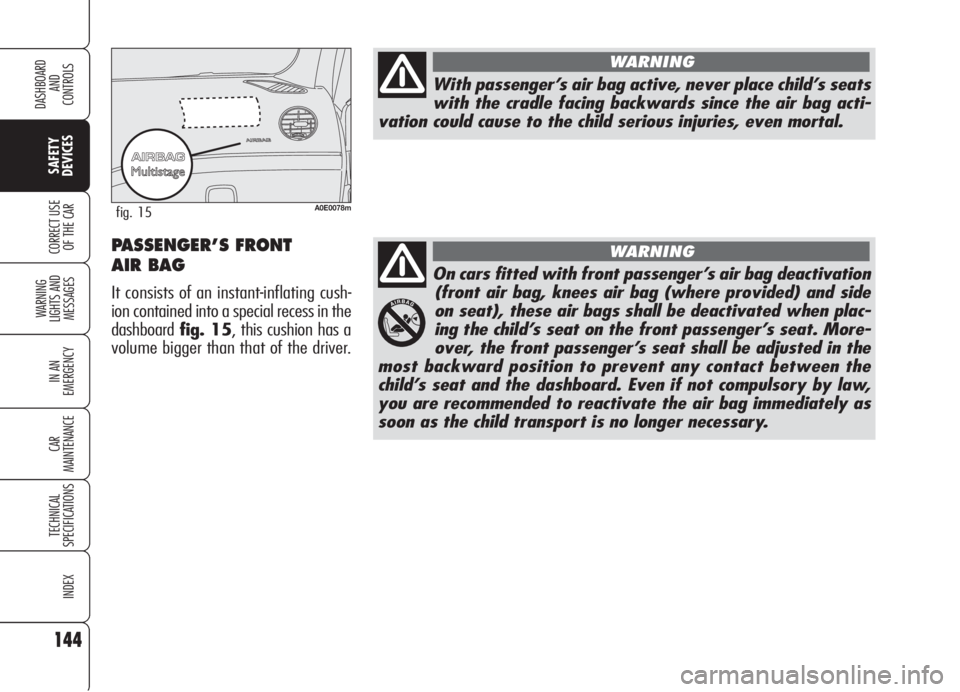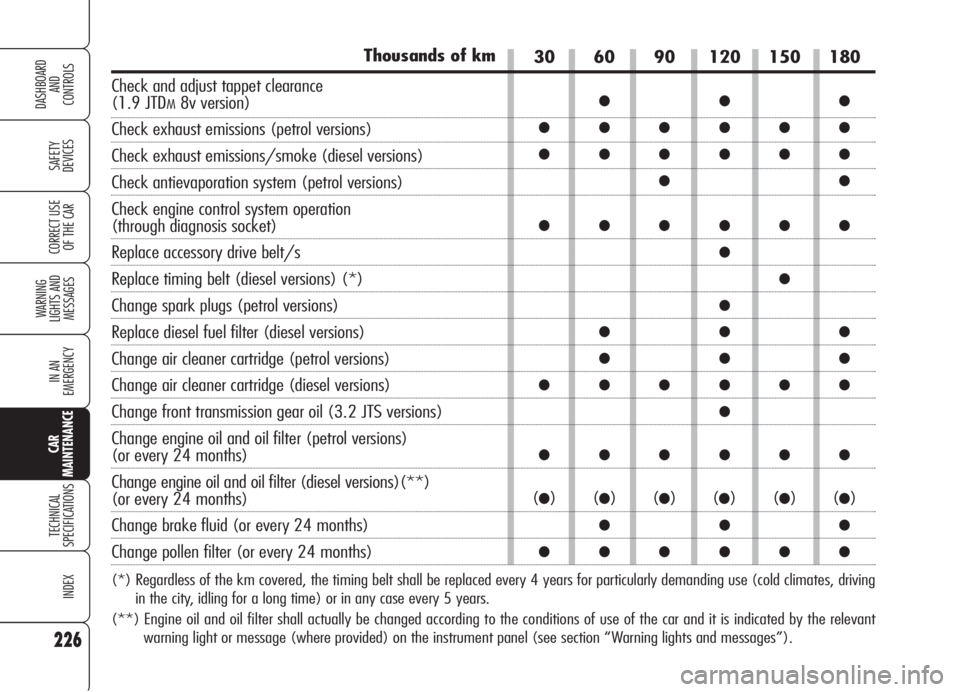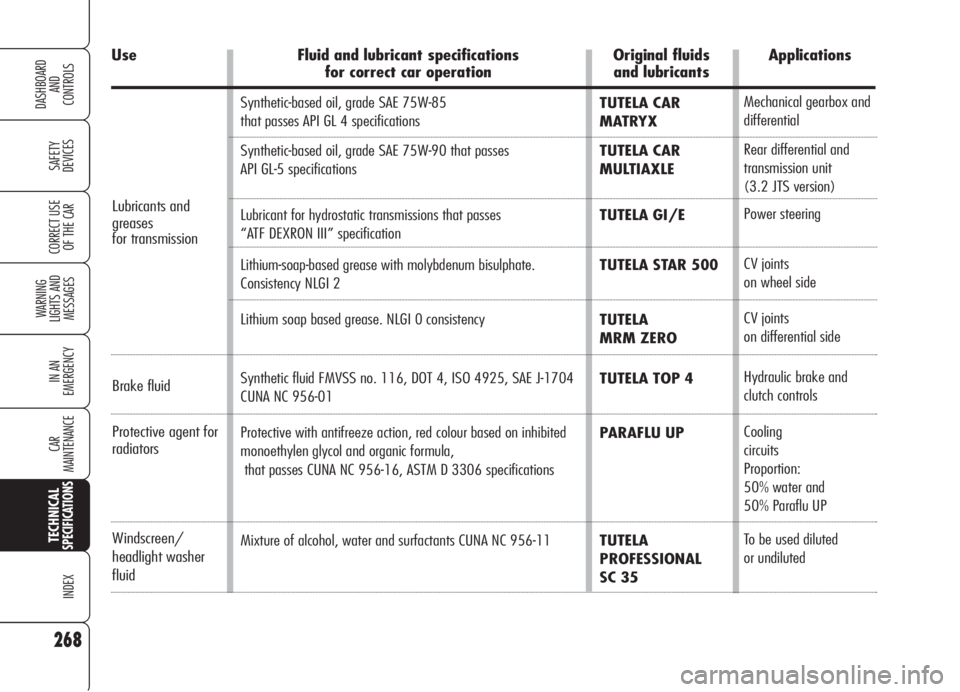trans Alfa Romeo 159 2006 Owner handbook (in English)
[x] Cancel search | Manufacturer: ALFA ROMEO, Model Year: 2006, Model line: 159, Model: Alfa Romeo 159 2006Pages: 299, PDF Size: 4.64 MB
Page 119 of 299

117
SAFETY
DEVICES
WARNING
LIGHTS AND
MESSAGES
IN AN
EMERGENCY
CAR
MAINTENANCE
TECHNICAL
SPECIFICATIONS
INDEX
CORRECT USE
OF THE CAR
DASHBOARD
AND
CONTROLS
RADIO TRANSMITTERS AND
CELLULAR TELEPHONES
Radio transceiver equipment (e.g.: e-
tacs mobile phones, HAM radio systems
and the like) shall not be used inside the
car unless a separate aerial is mounted
outside the car.
The use of these devices inside the pas-
senger compartment (without external
aerial) may cause electrical systems
equipping the car to malfunction. This
could compromise car safety in addition
to constituting a potential hazard for the
passengers.
In addition, transmission and reception
of these devices may be affected by the
shielding effect of the car body.
As concerns the use of mobile phones
(GSM, GPRS, UMTS) provided with of-
ficial EC approval, strictly comply with
the instructions given by the mobile
phone manufacturer.
ACCESSORIES
PURCHASED
BY THE OWNER
If after buying the car, you decide to in-
stall electrical accessories that require a
permanent electric supply (alarm, satel-
lite antitheft system, etc.) or accessories
that in any case burden the electric sup-
ply, contact Alfa Romeo Authorized Ser-
vices, whose qualified personnel, besides
suggesting the most suitable devices be-
longing to Lineaccessori Alfa Romeo, will
also evaluate the overall electric absorp-
tion, checking whether the car’s electric
system is able to withstand the load re-
quired, or whether it needs to be inte-
grated with a more powerful battery.
Take care when fitting
additional spoilers, al-
loy rims and non-standard
wheel caps: they might reduce
ventilation of the brakes, thus
their efficiency, during abrupt
and repeated braking, or long
downhill slopes. Make sure
that nothing (mats, etc.) gets
in the way of the pedals when
they are pushed down.
WARNING
Page 146 of 299

144
WARNING
LIGHTS AND
MESSAGES
IN AN
EMERGENCY
CAR
MAINTENANCE
TECHNICAL
SPECIFICATIONS
INDEX
CORRECT USE
OF THE CAR
DASHBOARD
AND
CONTROLS
SAFETY
DEVICES
On cars fitted with front passenger’s air bag deactivation
(front air bag, knees air bag (where provided) and side
on seat), these air bags shall be deactivated when plac-
ing the child’s seat on the front passenger’s seat. More-
over, the front passenger’s seat shall be adjusted in the
most backward position to prevent any contact between the
child’s seat and the dashboard. Even if not compulsory by law,
you are recommended to reactivate the air bag immediately as
soon as the child transport is no longer necessary.
A0E0078mfig. 15
With passenger’s air bag active, never place child’s seats
with the cradle facing backwards since the air bag acti-
vation could cause to the child serious injuries, even mortal.
WARNING
WARNINGPASSENGER’S FRONT
AIR BAG
It consists of an instant-inflating cush-
ion contained into a special recess in the
dashboardfig. 15, this cushion has a
volume bigger than that of the driver.
Page 198 of 299

196
SAFETY
DEVICES
WARNING
LIGHTS AND
MESSAGES
CAR
MAINTENANCE
TECHNICAL
SPECIFICATIONS
INDEX
CORRECT USE
OF THE CAR
DASHBOARD
AND
CONTROLS
IN AN
EMERGENCY
GENERAL INSTRUCTIONS
❒When a light is not working, check
that the corresponding fuse is intact
before changing a bulb. For the lo-
cation of fuses, refer to the paragraph
“If a fuse blows” in this section;
❒ Before changing a bulb check the con-
tacts for oxidation;
❒ Burnt bulbs must be replaced by oth-
ers of the same type and power;
❒Always check the height of the head-
light beam after changing a bulb.
IMPORTANTThe headlight inner sur-
face may be lightly misted over: this is
not a fault but a natural fact due to low
temperature and the level of air humid-
ity. It will disappear as soon the head-
lights are turned on. The presence of
drops inside the headlights means wa-
ter infiltration, therefore contact Alfa
Romeo Authorized Services.
WHEN NEEDING TO CHANGE A BULB
Modifications or re-
pairs to the electrical
system (electronic control
units) carried out incorrectly
and without bearing the fea-
tures of the system in mind
can cause malfunctions with
the risk of fire.
WARNING
Due to high voltage,
the bulb of (Bixenon)
gas-discharge headlights must
only be replaced by experts:
danger of death! Contact Alfa
Romeo Authorized Services.
WARNING
Halogen bulbs contain
pressurised gas which,
if broken, may cause small
fragments of glass to be pro-
jected outwards.
WARNING
Halogen bulbs must be
handled touching only
the metallic part. If the trans-
parent bulb is touched with the
fingers, its lighting intensity is
reduced and life of the bulb
may be compromised. If
touched accidentally, rub the
bulb with a cloth moistened
with alcohol and allow to dry.
WARNING
Page 223 of 299

221
SAFETY
DEVICES
WARNING
LIGHTS AND
MESSAGES
CAR
MAINTENANCE
TECHNICAL
SPECIFICATIONS
INDEX
CORRECT USE
OF THE CAR
DASHBOARD
AND
CONTROLS
IN AN
EMERGENCY
TOWING THE CAR
The tow hook provided with the car is
contained into the Fix&Go automatic
container.
A0E0111mfig. 64
PRECAUTIONS FOR
TOWING THE CAR
To prevent damaging the transmission
components, tow the car only in one of
following ways:
❒with front wheels raised and rear
wheels resting on a truck provided for
the purpose;
❒with rear wheels raised and front
wheels resting on a truck provided for
the purpose;
❒with front and rear wheels on the
flatbed of a wrecker or maintenance
vehicle.
TOW RING HOOKING
Front
Proceed as follows:
❒take the tow hookA-fig. 64from
the Fix&Go automatic container.
Page 228 of 299

226
SAFETY
DEVICES
WARNING
LIGHTS AND
MESSAGES
IN AN
EMERGENCY
TECHNICAL
SPECIFICATIONS
INDEX
CORRECT USE
OF THE CAR
DASHBOARD
AND
CONTROLS
CAR
MAINTENANCE
Thousands of km
Check and adjust tappet clearance
(1.9 JTDM8v version)
Check exhaust emissions (petrol versions)
Check exhaust emissions/smoke (diesel versions)
Check antievaporation system (petrol versions)
Check engine control system operation
(through diagnosis socket)
Replace accessory drive belt/s
Replace timing belt (diesel versions) (*)
Change spark plugs (petrol versions)
Replace diesel fuel filter (diesel versions)
Change air cleaner cartridge (petrol versions)
Change air cleaner cartridge (diesel versions)
Change front transmission gear oil (3.2 JTS versions)
Change engine oil and oil filter (petrol versions)
(or every 24 months)
Change engine oil and oil filter (diesel versions)(**)
(or every 24 months)
Change brake fluid (or every 24 months)
Change pollen filter (or every 24 months)
(*) Regardless of the km covered, the timing belt shall be replaced every 4 years for particularly demanding use (cold climates, driving
in the city, idling for a long time) or in any case every 5 years.
(**) Engine oil and oil filter shall actually be changed according to the conditions of use of the car and it is indicated by the relevant
warning light or message (where provided) on the instrument panel (see section “Warning lights and messages”).
30 60 90 120 150 180
●●●
●●●●●●
●●●●●●
●●
●●●●●●
●
●
●
●●●
●●●
●●●●●●
●
●●●●●●
(●)(●)(●)(●)(●)(●)
●●●
●●●●●●
Page 229 of 299

227
SAFETY
DEVICES
WARNING
LIGHTS AND
MESSAGES
IN AN
EMERGENCY
TECHNICAL
SPECIFICATIONS
INDEX
CORRECT USE
OF THE CAR
DASHBOARD
AND
CONTROLS
CAR
MAINTENANCE
USE OF THE CAR
UNDER HEAVY
CONDITIONS
Should prevailing use of the car be un-
der one of the following specially heavy
conditions:
❒ trailer or caravan towing;
❒ dusty roads;
❒ short distances (less than 7-8 km)
and repeated with external temper-
atures below zero;
❒ frequently idling engines or long dis-
tance low speed driving (e.g.: door-
to-door deliveries) or in case of a long
term inactivity;
❒ urban routes;
carry out checks more frequently than
required on Service Schedule:
❒ check front disk brake pad conditions
and wear;
❒ check cleanness of bonnet and boot
locks and lever cleanness and lubri-
cation;
❒ sight inspect the conditions of: en-
gine, gearbox, transmission, pipes
and hoses (exhaust - fuel - brakes),
rubber parts (boots, sleeves, bushes,
etc.);
❒ check battery charge and fluid level
(electrolyte);
❒ visual check on various drive belt con-
ditions;
❒ change engine oil and oil filter, if re-
quired;
❒ check and replace pollen filter, if re-
quired;
❒ check and replace air cleaner, if re-
quired.
PERIODICAL CHECKS
Every 1,000 km or before long jour-
neys, check and top up if required:
❒engine coolant fluid level;
❒brake fluid level;
❒windscreen washer fluid level;
❒ tyre pressure and conditions.
❒ check light system operation (head-
lights, direction indicators, hazard
lights, etc.);
❒ check windscreen wiper/washer op-
eration and windscreen/rear window
blade position/wear;
Every 3,000 km check and top up if re-
quired: engine oil level.
You are recommended to use FL Se-
leniaproducts, designed and produced
specifically for Alfa Romeo cars (see
table “Capacities” in section “Techni-
cal specifications”).
Page 248 of 299

Exterior plastic parts must be cleaned in
the same way as the rest of the car.
Where possible, do not park under trees;
the resinous substance many species re-
lease give the paint a dull appearance
and increase the possibility of triggering
rust processes.
IMPORTANTBird droppings must be
washed off immediately and thorough-
ly as the acid they contain is particular-
ly aggressive.
246
SAFETY
DEVICES
WARNING
LIGHTS AND
MESSAGES
IN AN
EMERGENCY
TECHNICAL
SPECIFICATIONS
INDEX
CORRECT USE
OF THE CAR
DASHBOARD
AND
CONTROLS
CAR
MAINTENANCE
Windows
Use specific window cleaner products. Use
also clean cloths to avoid scratching the
glass or damaging the transparency.
IMPORTANTThe inside of the
rearscreen should be wiped gently with
a cloth in the direction of the filaments
to avoid damaging the heating device.
Front headlights
Front headlights shall be washed with
soft cloth moistened with water and car
detergent.
IMPORTANT Cleaning headlight lens-
es with a dry cloth will damage the
headlights with lack of performance as
a consequence. Solvents mat the lens-
es with lack of performance as a con-
sequence.
IMPORTANT When washing the front
headlights with a water monitor noz-
zle keep at least 2 cm away from the
lenses. To wash the car correctly proceed as fol-
lows:
❒remove the aerial from the roof to
prevent damage to it if the car is
washed in an automatic system;
❒wash the body using a low pressure
jet of water;
❒wipe a sponge with a slightly soapy
solution over the bodywork, fre-
quently rinsing with the sponge;
❒rinse well with water and dry with a
jet of air or a chamois leather.
When drying, take particular care with
the less visible parts like door surrounds,
bonnet and around the headlights where
water may stagnate. The car should not
be taken to a closed area immediately,
but left in the open so that residual wa-
ter can evaporate.
Do not wash the car after it has been left
in the sun or with the bonnet hot: this
may alter the shine of the paintwork.
Detergents cause water
pollution. Therefore the
car should be washed
in areas equipped for collecting
and purifying the liquid used in
the washing process.
Page 251 of 299

249
SAFETY
DEVICES
WARNING
LIGHTS AND
MESSAGES
IN AN
EMERGENCY
CAR
MAINTENANCE
INDEX
CORRECT USE
OF THE CAR
DASHBOARD
AND
CONTROLS
TECHNICALSPECIFICATIONS
T T
E E
C C
H H
N N
I I
C C
A A
L L
S S
P P
E E
C C
I I
F F
I I
C C
A A
T T
I I
O O
N N
S S
IDENTIFICATION DATA ......................................... 250
ENGINE CODES - BODYWORK VERSIONS ............... 252
ENGINE ............................................................ 253
FUEL FEED/IGNITION ........................................ 255
TRANSMISSION ................................................ 255
BRAKES ............................................................ 256
STEERING.......................................................... 256
SUSPENSIONS................................................... 256
WHEELS ........................................................... 257
DIMENSIONS..................................................... 261
PERFORMANCE .................................................. 263
WEIGHTS .......................................................... 264
CAPACITIES........................................................ 266
FLUIDS AND LUBRICANTS .................................... 267
FUEL CONSUMPTION .......................................... 269
CO
2EMISSIONS ............................................... 270
Page 257 of 299

255
SAFETY
DEVICES
WARNING
LIGHTS AND
MESSAGES
IN AN
EMERGENCY
CAR
MAINTENANCE
INDEX
CORRECT USE
OF THE CAR
DASHBOARD
AND
CONTROLS
TECHNICALSPECIFICATIONS
FUEL FEED/IGNITION
1.9 JTS - 2.2 JTS - 3.2 JTS1.9 JTDM8V-1.9 JTDM16v
2.4 JTDM
Fuel feed Direct injection Direct injection, Common Rail
Modifications or repairs to the fuel feed system that are not carried out properly or do not
take the system’s technical specifications into account can cause malfunctions leading to
the risk of fire.
TRANSMISSION
Gearbox
Clutch
Drive
IMPORTANTIn the event of difficult disengagement, due to significant difference of grip between front and rear axle, do
not insist with heavy accelerations: it is actually more effective an attempt of disengagement at medium slow engine rpm,
with pauses of a few seconds if several attempts are necessary.
1.9 JTS - 2.2 JTS - 1.9 JTDM8V
1.9 JTDM16v - 2.4 JTDM
Six forward gears + reverse and
synchronisers for speeds
Dry single disk
with hydraulic control
Front3.2 JTS
Six forward gears + reverse and
synchronisers for speeds
Dry single disk
with hydraulic control
Four-wheel drive
Page 270 of 299

268
SAFETY
DEVICES
WARNING
LIGHTS AND
MESSAGES
IN AN
EMERGENCY
CAR
MAINTENANCE
INDEX
CORRECT USE
OF THE CAR
DASHBOARD
AND
CONTROLS
TECHNICALSPECIFICATIONS
Synthetic-based oil, grade SAE 75W-85
that passes API GL 4 specifications
Synthetic-based oil, grade SAE 75W-90 that passes
API GL-5 specifications
Lubricant for hydrostatic transmissions that passes
“ATF DEXRON III” specification
Lithium-soap-based grease with molybdenum bisulphate.
Consistency NLGI 2
Lithium soap based grease. NLGI 0 consistency
Synthetic fluid FMVSS no. 116, DOT 4, ISO 4925, SAE J-1704
CUNA NC 956-01
Protective with antifreeze action, red colour based on inhibited
monoethylen glycol and organic formula,
that passes CUNA NC 956-16, ASTM D 3306 specifications
Mixture of alcohol, water and surfactants CUNA NC 956-11TUTELA CAR
MATRYX
TUTELA CAR
MULTIAXLE
TUTELA GI/E
TUTELA STAR 500
TUTELA
MRM ZERO
TUTELA TOP 4
PARAFLU UP
TUTELA
PROFESSIONAL
SC 35Mechanical gearbox and
differential
Rear differential and
transmission unit
(3.2 JTS version)
Power steering
CV joints
on wheel side
CV joints
on differential side
Hydraulic brake and
clutch controls
Cooling
circuits
Proportion:
50% water and
50% Paraflu UP
To be used diluted
or undiluted
Use Fluid and lubricant specifications Original fluids Applications
for correct car operation and lubricants
Lubricants and
greases
for transmission
Windscreen/
headlight washer
fluid Protective agent for
radiators Brake fluid